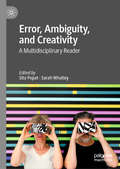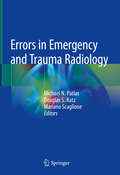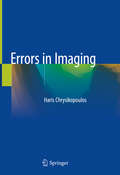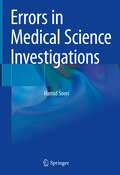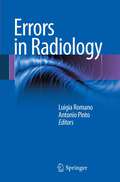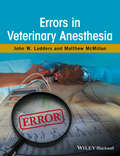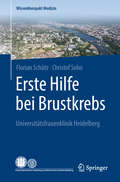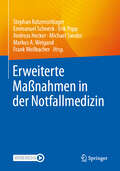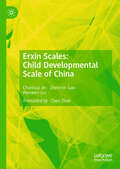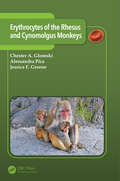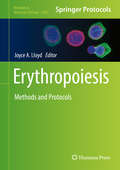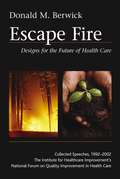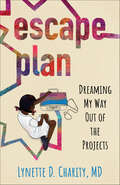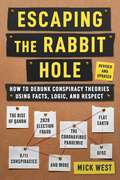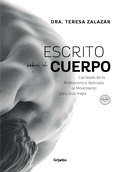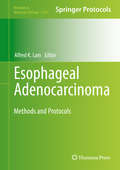- Table View
- List View
Error, Ambiguity, and Creativity: A Multidisciplinary Reader
by Sarah Whatley Sita PopatThis book offers a set of eleven discipline-specific chapters from across the arts, humanities, psychology, and medicine. Each contributor considers the creative potential of error and/or ambiguity, defining these terms in the particular context of that discipline and exploring their values and applications. Themes include error in choreography, poetry, media art, healthcare, psychology, critical typography and mixed reality performance. The book emerges from a core question of how dance research and HCI can inform each other through consideration of error, ambiguity and ‘messiness’ as methodological tools. The digital age had heralded the possibility that error could be eradicated by the logic of computers but several chapters focus on glitch in arts practices that exploit errors in computer programmes, or even create programmes specifically to produce errors. Together, the chapters explore how error can take us somewhere different or somewhere new, to develop a new, more interesting way of working.
Errors in Emergency and Trauma Radiology
by Mariano Scaglione Douglas S. Katz Michael N. PatlasThis book describes and illustrates the gamut of errors that may arise during the performance and interpretation of imaging of both nontraumatic and traumatic emergencies, using a head-to-toe approach. The coverage encompasses mistakes related to suboptimal imaging protocols, failure to review a portion of the examination, satisfaction of search error, and misinterpretation of imaging findings. The book opens with an overview of an evidence-based approach to errors in imaging interpretation in patients in the emergency setting. Subsequent chapters describe errors in radiographic, US, multidetector CT, dual-energy CT, and MR imaging of common as well as less common acute conditions, including disorders in the pediatric population, and the unique mistakes in the imaging evaluation of pregnant patients. The book is written by a group of leading North American and European Emergency and Trauma Radiology experts. It will be of value to emergency and general radiologists, to emergency department physicians and related personnel, to general and trauma surgeons, and to trainees in all of these specialties.
Errors in Imaging
by Haris ChrysikopoulosThis book offers a thorough, clear and practical guide to identifying, preventing and correcting any error or bias that may arise during the interpretation and reporting of medical images. It combines information and insights from the fields of radiology, expertise theory, cognitive psychology, and advanced learning practices with the author’s considerable clinical (radiologic) experience. In addition, the book features an extensive “Teaching Cases Section” that simulates real-world situations, giving readers an opportunity to practice what they have just learned. The purpose of the book is to provide readers with essential information and strategies, and to point out the deficiencies of the current radiology education system, in order to minimize the occurrence and the clinical impact of errors in imaging by offering the proper education and training for imaging professionals. It offers a valuable guide for diagnostic radiologists and all other imaging professionals, whether in training or in practice. Though the main emphasis is on computed tomography and magnetic resonance, the general principles are applicable to all conventional imaging modalities.
Errors in Medical Science Investigations
by Hamid SooriThis book introduces all common errors in medical science fields and the ways to control them. Systematic errors could be controlled both during study design and statistical analysis. Some errors have been presented in small segments but not in a comprehensive book. It covers many common errors that usually affect the research proposals, final reports, theses, and scientific presentations in the field of medical sciences as well as the rejection reasons on scientific papers. It will help researchers to control common errors using epidemiological and statistical methods.
Errors in Radiology
by Antonio Pinto Luigia RomanoDiagnostic errors are important in all branches of medicine because they are an indication of poor patient care. As the number of malpractice cases continues to grow, radiologists will become increasingly involved in litigation. The aetiology of radiological error is multi-factorial. This book focuses on (1) some medico-legal aspects inherent to radiology (radiation exposure related to imaging procedures and malpractice issues related to contrast media administration are discussed in detail) and on (2) the spectrum of diagnostic errors in radiology. Communication issues between the radiologists and physicians and between the radiologists and patients are also presented. Every radiologist should understand the sources of error in diagnostic radiology as well as the elements of negligence that form the basis of malpractice litigation.
Errors in Veterinary Anesthesia
by John W. Ludders Matthew W. McmillanErrors in Veterinary Anesthesia is the first book to offer a candid examination of what can go wrong when anesthetizing veterinary patients and to discuss how we can learn from mistakes. Discusses the origins of errors and how to learn from mistakes Covers common mistakes in veterinary anesthesia Provides strategies for avoiding errors in anesthetizing small and large animal patients Offers tips and tricks to implement in clinical practice Presents actual case studies discussing errors in veterinary anesthesia
Erschöpfung und Burnout vorbeugen – mit Qigong und TCM: Übungen zur Selbsthilfe
by Angela CooperDie Belastungen steigen, die Kräfte schwinden: Ein Burnout droht. In diesem Ratgeber finden Sie praktische Anregungen, wie Sie wieder entspannen, genießen und frische Energie sammeln, anstatt erschöpft, gestresst und ausgebrannt To-do-Listen abzuarbeiten. Sie erfahren, was Sie selbst dazu beitragen können, um Burnout vorzubeugen oder zu lindern. Das alles gelingt mit dem jahrtausendealten Wissen des Qigong, der altchinesischen Philosophie und der Traditionellen Chinesischen Medizin, kurz TCM. Wie achten Sie liebevoll auf Ihre Grenzen? Wie lernen Sie neugierig aus Krisen? Wie bewältigen Sie Herausforderungen gelassen? Wie entdecken Sie Ihre Kraftquellen? Antworten darauf finden sich in den wichtigsten Weisheits-Lehren der TCM: dem 5-Elemente-Modell und dem Yin-Yang-Prinzip. Der Ratgeber erklärt das Burnout-Phasenmodell aus TCM-Sicht. Für jede Burnout-Phase finden Sie praktische Selbsthilfe-Tipps sowie einfache, aber wirkungsvolle Übungen für Körper, Geist und Seele. Mithilfe der klaren Anleitungen, Bilder und Videos erlernen Sie die kraftspendenden Atem-, Bewegungs- und Meditations-Übungen in wenigen Minuten. So können Sie endlich wieder genussvoll entspannen, tief durchatmen und jeden Tag freudig beginnen.
Erstaunliches über unser Herz: Wissen für Herzkranke und Herzgesunde
by Achim BarmeyerWie stark ist das Herz? Woher weiß das Herz, wann es schlagen muss? Wie bemerkt man eine Herzschwäche? Können Herzklappenfehler auch ohne Operation behandelt werden? In diesem Taschenbuch beantwortet der Arzt und Autor in unterhaltsamer und verständlicher Art und Weise diese und alle anderen Fragen rund um das Thema Herz, seine Erkrankungen, woher sie kommen, wie sie untersucht und behandelt werden. Ideal zum Nachschlagen, egal ob man gesund ist und mehr über die Pumpe in seinem Körper wissen will oder kurz vor einem Herzkatheter steht. Man erfährt viel Neues und Erstaunliches über unser Organ Herz.
Erste Hilfe am Berg: Unfälle und Notfälle beim Wandern, Bergsteigen und Klettern
by Josef Burger Alexander Egger Stefan Heschl Tobias Huber Markus Isser Matthias Pimiskern Roland Rauter Joachim SchieferAuch bei umsichtiger Tourenplanung können Verletzungen und Erkrankungen im Rahmen von alpinistischen Unternehmungen nicht vollständig vermieden werden. Um für derartige Ausnahmesituationen gerüstet zu sein, hilft es, die wesentlichen Handlungsschritte der Ersten Hilfe im alpinen Gelände zu kennen. Der fundierte Ratgeber herausgegeben von erfahrenen Alpin- und Notfallmedizinern des Bergrettungsdienstes Österreich bietet hierfür das erforderliche Wissen. Es werden die relevanten Erste-Hilfe-Maßnahmen praxisorientiert und einfach beschrieben und in Wort, Bild und Videos vorgestellt.Ein besonderes Augenmerk liegt auf den speziellen Umständen, die eine Erste-Hilfe-Leistung im alpinen Gelände unter häufig widrigen Wetterbedingungen mit sich bringt. Effektiv und einfach kann auch mit wenigen Ausrüstungsgegenständen geholfen werden. Neben den Erste-Hilfe-Tipps finden sich auch hilfreiche Informationen zur optimalen Ausstattung einer Notfallapotheke im Rucksack sowie zu bewährten Verhaltensregeln am Berg. Der Ratgeber richtet sich an alle Menschen, die im Gebirge unterwegs sind, gleichsam Wanderer, Bergsteiger, Tourengeher, Kletterer, Jäger, Forstarbeiter und Sanitäter.
Erste Hilfe bei Brustkrebs: Universitätsfrauenklinik Heidelberg (Wissenkompakt Medizin Ser.)
by Florian Schütz Christof SohnDas vorliegende Buch der Reihe WissenKompakt Medizin richtet sich an alle Patientinnen und deren Familien, die mit der Diagnose „Brustkrebs“ konfrontiert werden. Vom Umgang mit dem ersten Schock der Diagnose über operative, konservative und ergänzende Behandlungsmethoden klären Experten der Universitätsfrauenklinik Heidelberg auf. Ebenso sind medizinische Grundlagen und sozialrechtliche Aspekte verständlich und nachvollziehbar erläutert.Das Wissen um die Erkrankung ist der wichtigste Schritt in der Behandlung dieser! Betroffenen Frauen und ihren Familien soll dieses Buch Mut machen, mit der Erkrankung umzugehen und sie als Ratgeber im Alltag begleiten.
Erste Hilfe bei Sportverletzungen: FIT statt PECH
by Henk J.M. Brils Jens BrilsDieses Sachbuch liefert alles Wesentliche für die Erstversorgung von Verletzungen an Muskeln, Sehnen und Bändern in Sport, Freizeit, Training und Physiotherapie. Die in der Ersten Hilfe allseits bekannte PECH-Regel empfiehlt die Schonung, Kühlung, Komprimierung und Hochlagerung von verletztem Gewebe. Die FIT-Regel (Funktion - Information - Therapie) hingegen unterstützt und nutzt die physiologischen Heilungsprozesse des Körpers, statt sie zu unterdrücken. Die Autoren stellen die beiden Ansätze gegenüber und erklären, weshalb wir den physiologischen Reaktionen unseres Körpers vertrauen dürfen und wie die FIT-Regel uns schneller wieder fit macht. Sie beantworten dabei Fragen, wie z. B.: Was ist Orthodynamik und welchen Einfluss hat sie auf den Heilungsprozess? Warum wirkt Wärme heilungsfördernd? Mit welchen Maßnahmen kann die Zellgesundheit unterstützt werden?Aus dem Inhalt:Zellen und ZellgesundheitVerletzungsanfällige Körperteile und PräventionHeilungsprozesse und OrthodynamikErstversorgung von (Sport-)VerletzungenVerstehen Sie physiologische Vorgänge nach Verletzungen, unterstützen Sie gezielt den Heilungsprozess und läuten auch Sie das Ende der Eiszeit ein!
Erste Hilfe in den Bergen: Unfälle und Notfälle beim Wandern, Bergsteigen und Klettern
by Josef Burger Alexander Egger Stefan Heschl Tobias Huber Markus Isser Matthias Pimiskern Roland Rauter Joachim SchieferAuch bei umsichtiger Tourenplanung können Verletzungen und Erkrankungen im Rahmen von alpinistischen Unternehmungen nicht vollständig vermieden werden. Um für derartige Ausnahmesituationen gerüstet zu sein, hilft es, die wesentlichen Handlungsschritte der Ersten Hilfe im alpinen Gelände zu kennen. Der fundierte Ratgeber herausgegeben von erfahrenen Alpin- und Notfallmedizinern des Bergrettungsdienstes Österreich bietet hierfür das erforderliche Wissen. Es werden die relevanten Erste-Hilfe-Maßnahmen praxisorientiert und einfach beschrieben und in Wort, Bild und Videos vorgestellt.Ein besonderes Augenmerk liegt auf den speziellen Umständen, die eine Erste-Hilfe-Leistung im alpinen Gelände unter häufig widrigen Wetterbedingungen mit sich bringt. Effektiv und einfach kann auch mit wenigen Ausrüstungsgegenständen geholfen werden. Neben den Erste-Hilfe-Tipps finden sich auch hilfreiche Informationen zur optimalen Ausstattung einer Notfallapotheke im Rucksack sowie zu bewährten Verhaltensregeln am Berg. Der Ratgeber richtet sich an alle Menschen, die im Gebirge unterwegs sind, gleichsam Wanderer, Bergsteiger, Tourengeher, Kletterer, Jäger, Forstarbeiter und Sanitäter.
Erupción de Permafrost
by Louis P. KichaUn virus y una bacteria pasaron treinta mil años en hibernación en el profundo permafrost. Liberados por el cambio climático, ahora están causando enfermedades y muertes a una población vulnerable. ¡Serán necesarios todos los conocimientos, habilidades y destrezas que los doctores Raymond Salazar y Peter Fleming puedan reunir para comprender y derrotar a los mortales organismos antes de que el planeta sea devastado!
Erweiterte Maßnahmen in der Notfallmedizin
by Stephan Katzenschlager Emmanuel Schneck Erik Popp Andreas Hecker Michael Sander Markus A. Weigand Frank WeilbacherErweiterte Maßnahmen sind Verfahren, die über die regulären notfallmedizinischen Basismaßnahmen hinausgehen und für Patient:innen lebensrettend sein können. Ihre Invasivität und Komplexität erfordern ein hohes Maß an Wissen und Können. Dieses Praxisbuch beschreibt die verschiedenen Verfahren und Techniken bei Erwachsenen, Kindern und Schwangeren. Zahlreiche Praxistipps, Fallbeispiele und Videos zu einzelnen Verfahren machen das Werk besonders praxistauglich. Themen sind u.a. Atemwegsmanagement, inkl. hyperanguliertem Videolaryngoskop und Bougie, chirurgische Atemwege (emergency Front of Neck Access), Suction-Assisted Laryngoscopy and Airway Decontamination, Thorakostomie, Clamshell Thorakotomie, Resuscitative Endovascular Ballooning of the Aorta, extrakorporale Membranoxygenierung, inkl. extrakorporale Reanimation, Bestimmung des Optic Nerve Sheat Diameter, Pediatric Advanced Life Support, Notfallhysterostomie. Auch auf die Rolle erweiterter Maßnahmen während MANV-Situationen geht das Werk ein. Es wendet sich an alle prähospital tätigen Notärzt:innen und erfahrenes Rettungsdienstfachpersonal sowie an alle Ärzt:innen, die in Zentralen Notaufnahmen innerklinische Notfälle versorgen.
Erwerbsverlauf und sozialer Schutz in Europa: Employment Biographies and Social Protection in Europe . Les parcours professionnels et la protection sociale en Europe
by Sylvie Hennion Otto Kaufmann Eva Maria HohnerleinMit dem Anstieg der Lebenserwartung in Europa geht ein Wandel der Erwerbs- und Lebensverläufe einher, die durch Brüche und Wechsel der beruflichen Tätigkeiten geprägt sind. Ein zentrales Anliegen ist daher, jedem die Teilhabe am Erwerbsleben über den gesamten Lebensverlauf zu ermöglichen und zugleich soziale Rechte durch angemessenen sozialen Schutz zu gewährleisten. Mit juristischen, sozialpolitischen und empirischen Analysen widmet sich dieses Buch dem Zusammenspiel verschiedener Sozialschutzmechanismen und ihren Schwierigkeiten, sich den neuen Entwicklungen anzupassen. Es präsentiert die Impulse europäischer Instanzen und die Antworten verschiedener europäischer Staaten auf die Herausforderung, Flexibilisierung der Beschäftigung und Modernisierung der Sozialschutzsysteme in Einklang zu bringen.Increasing life expectancy in Europe entails a remodelling of career development and life course, marked by discontinuities and changing professional activities. One of the concerns is ensuring that everybody may participate in gainful activities during his or her life course while also guaranteeing social rights through adequate social protection. By means of legal, socio-political and empirical analyses this book embarks on the interrelationship of different social protection mechanisms and the resulting difficulties of adapting to these new employment patterns. It presents European impulses and the reactions of several European states to the challenge of reconciling flexibility of employment and modernisation of social protection.L’augmentation de l’espérance de vie en Europe suscite un changement des modes de parcours professionnels et de vie constitués de ruptures et de conversions d’activité. L’une des préoccupations est de permettre à chacun de poursuivre une activité professionnelle tout au long de sa vie tout en pouvant bénéficier d’une protection sociale adaptée. A travers des analyses juridiques, socio-politiques et empiriques, cet ouvrage aborde les interférences et les difficultés d’adaptation des mécanismes de protection sociale aux nouvelles évolutions. Il présente les impulsions européennes et les choix effectués au niveau national pour concilier flexibilité de l’emploi et modernisation des systèmes de protection sociale.
Erxin Scales: Child Developmental Scale of China
by Chunhua Jin Zhenmin Gao Wenwen LiuThis book, drawing from internationally renowned scales like Bayley and Gesell, develops a child developmental assessment scale based on research data from Chinese children. It stands as a meticulous creation of the Capital Institute of Pediatrics, a national-level institution for children’s development research in China. The scale demonstrates good reliability and validity, meeting psychometric standards in various statistical aspects. In the revised scale, developmental quotients are classified into six levels, distributions of percentiles for developmental quotients are provided, and screening indices for autism spectrum disorders are added. In doing so, the revised scale can not only identify developmental delays but also concurrently screen for autism spectrum disorder risks, providing a foundational reference for tracking children’s developmental status in follow-up studies. The book holds vital value and significance in fostering communication among scholars from universities and research institutions, as well as pediatricians, neurologists, and rehabilitation specialists in hospitals.
Erythrocytes of the Rhesus and Cynomolgus Monkeys
by Chester A. Glomski Alessandra Pica Jessica F. GreeneErythrocytes of the Rhesus and Cynomolgus Monkeys addresses the morphologic, quantitative, and generative aspects of the erythrocytes of the rhesus monkey Macaca mulatta and the cynomolgus monkey Macaca fascicularis (long-tailed macaque, crab-eating monkey). These two species are the most commonly selected nonhuman primates for basic science and cl
Erythropoiesis
by Joyce A. LloydThis detailed volume provides thorough protocols describing how to use genetics to study mouse and zebrafish erythropoiesis in whole animal models and for genetically manipulating cultured mouse and human erythroid cells. Protocols include strategies to analyze circulating red blood cell parameters, as well as progenitor cell status, stage of differentiation, and enucleation. Methods for the study of erythroid cell gene regulation using chromatin immunoprecipitation and chromatin conformation capture are detailed. Furthermore, protocols are provided to examine stress erythropoiesis, erythroblastic islands, and erythroblast structure. The collection also includes reviews on the available mouse models of erythropoiesis, as well as on future considerations for good manufacturing practice in order to translate the manufacture of erythrocytes to the clinic. Written for the highly successful Methods in Molecular Biology series, chapters include introductions to their respective topics, lists of the necessary materials and reagents, step-by-step, readily reproducible laboratory protocols, and tips on troubleshooting and avoiding known pitfalls. Authoritative and practical, Erythropoiesis: Methods and Protocols provides a definitive source for molecular and cellular biology protocols to study erythropoiesis and to move this vital field forward.
Esa nueva piel: Sobre la maternidad, el duelo y sus alrededores
by Eugenia Tobal«Un testimonio sin imposturas, sin falsos paraísos, sin espejismos. Eugenia Tobal recorre su propia historia, la de su embarazo, su gestación, su parto. E incluye el duelo, esa contradictoria lucha entre la vida y la muerte que nunca imagino vivir de forma tan prematura».Sonia Fides «Dos meses después del nacimiento de Ema, mi madre murió, así que mi soñada y flamante maternidad coincidió con un duelo que en este momento presiento eterno. Sin embargo, qué mejor homenaje puedo brindarles a mi madre y a mi hija que reunirlas en Esa nueva piel, prolongando el encuentro entre las tres, escribiendo nuestro linaje con palabras que van a perdurar en el tiempo». Así anuncia Eugenia Tobal el "paisaje" de su obra. El dolor por la pérdida de su madre y la felicidad por el nacimiento de su primera hija están presentes en cada página con la sutileza de una banda sonora, una melodía suave, honesta, sensible, que resuena por detrás de cada tema que el libro aborda. La propuesta de Esa nueva piel es "demoler mitos y despejar ese suelo tan movedizo que pisamos en la maternidad" y, sobre todo, vivirla sin culpas, sin miedos y con la verdad. Para ello, la autora no solo comparte su experiencia personal, sino que además les da voz a especialistas y a otras mujeres que llegaron a ser madres de diferentes maneras. La voz emotiva, íntegra y delicada de Tobal fluye en cada página, avanza, valiente, por los territorios más espinosos -la maternidad, la muerte, el nacimiento, el duelo- y nos invita a celebrar la vida mirándola siempre de frente.
Escape Fire: Designs for the Future of Health Care
by Donald M. BerwickSpanning a decade (1992-2002), these speeches echo the theme that our health care system needs fundamental change and a revolutionary new design. Throughout the book, Berwick identifies innovations and ideas from a number of surprising sources—a girls' soccer team, a sinking ship, and the safety standards at NASA. Escape Fire takes its title from the 1949 Mann Gulch tragedy in which thirteen young firefighters were trapped in a wildfire on a Montana hillside. The firefighter's leader, Wag Dodge, devised a creative solution for avoiding the encroaching fire. He burned a patch of grass and lay down in the middle of the scorched earth. His team refused to join him, and most perished in the fire. Dodge survived. Berwick applies the lessons learned from the catastrophe to our ailing health care system—we must not let ingrained processes obstruct life-saving innovation. Not content to simply define the problems with our flawed system, Berwick outlines new designs and suggests practical tools for change: name the problem, build on success, take leaps of faith, look outside of the medical field, set aims, understand systems, make action lists, and—the most fundamental of all—never lose sight of the patient as the central figure.
Escape Plan: Dreaming My Way Out of the Projects
by Lynette D. CharityLynette Charity’s grit, grief, and gratitude will have readers rooting for this timeless memoir about growing up in the early ‘60s South and overcoming all the odds against her to become a doctor in a time when the idea of a Black woman physician was practically unheard of.At nine years old, Lynette Charity looked on, frozen in place, as her father hit her mother so hard that she flipped over their front porch railing and fell into the hedges below. That night, young Lynette hatched a plan: she would escape this life, no matter what it took. And a month later, after watching the first episode of a new show called Ben Casey, she decided that becoming a doctor was her way out. At some point, Lynette noticed that all the real doctors and nurses who took care of her were Black and all the make-believe doctors and nurses on TV were white. Did it make a difference? Not to her. Over the next decade-plus, she focused on her studies. At a time when segregation was still alive and well in Virginia, she forged her mother’s signature on transfer papers so she could go to a better-resourced white school on the other side of town. Upon finishing high school, she got a full ride to Pittsburgh’s Chatham College. And after graduating Chatham with honors, she became a member of Tufts University School of Medicine's Class of 1978, one of seven Black women in her class. Raw, candid, and inspiring, Escape Plan is the remarkable story of how, through perseverance and single-minded determination, a Black girl from the 1960s South faced down adversity, exceeded everyone’s expectations, and fulfilled her dreams.
Escaping the Rabbit Hole: How to Debunk Conspiracy Theories Using Facts, Logic, and Respect (Revised and Updated - Includes Information about 2020 Election Fraud, The Coronavirus Pandemic, The Rise of QAnon, and UFOs)
by Mick WestRevised and updated for the first time in 2023—Now includes strategies for debunking conspiracies regarding the coronavirus pandemic, election fraud, QAnon, UFOs, and more. The Earth is flat, the World Trade Center collapse was a controlled demolition, planes are spraying poison to control the weather, and actors faked the Sandy Hook massacre. All these claims are bunk: falsehoods, mistakes, and in some cases, outright lies. But many people passionately believe one or more of these conspiracy theories. They consume countless books and videos, join like-minded online communities, try to convert those around them, and even, on occasion, alienate their own friends and family. Why is this, and how can you help people, especially those closest to you, break free from the downward spiral of conspiracy thinking? In Escaping the Rabbit Hole, author Mick West shares over a decade&’s worth of knowledge and experience investigating and debunking false conspiracy theories through his forum, MetaBunk.org, and sets forth a practical guide to helping friends and loved ones recognize these theories for what they really are. Perhaps counter-intuitively, the most successful approaches to helping individuals escape a rabbit hole aren&’t comprised of simply explaining why they are wrong; rather, West&’s tried-and-tested approach emphasizes clear communication based on mutual respect, honesty, openness, and patience. West puts his debunking techniques and best practices to the test with the most popular false conspiracy theories today (Chemtrails, The Coronavirus Pandemic, 9/11 Controlled Demolition, Election Fraud, False Flags, Flat Earth, The Rising of QAnon, and UFOs)—providing road maps to help you to understand your friend and help them escape the rabbit hole. These are accompanied by real-life case studies of individuals who, with help, were able to break free from conspiracism. With sections on: the wide spectrum of conspiracy theoriesavoiding the &“shill&” labelpsychological factors and other complications(and concluding with) a look at the future of debunking Mick West has put forth a conclusive, well-researched, practical reference on why people fall down the conspiracy theory rabbit hole and how you can help them escape.
Escherichia coli, a Versatile Pathogen (Current Topics in Microbiology and Immunology #416)
by Gad Frankel Eliora Z RonEscherichia coli is a facultative anaerobic Gamma-proteobacterium, which belongs to the family Enterobacteriaceae. While being an important constituent of the normal gut microbiota, specialized E. coli clones have acquired genetic elements that allow them to compete with the endogenous commensals, colonise normally sterile niches and cause disease. E. coli pathotypes can cause intestinal and extra intestinal infections (e.g. UTI, sepsis) and associate with mammalian cells while being extra- or intra-cellular. In recent years, E. coli infections have become a serious clinical problem, due to the rapid spread of antibiotic resistance. Thus, infections with intestinal E. coli (e.g. E. coli O104) or extraintestinal pathogenic strains (e.g. E. coli ST131) are becoming difficult to treat and are often lethal. Consequently, there is a pressing need to develop alternative control measures, including the identification of new drug targets and development of vaccines that offer lasting protection. This volume focuses on several types of E. coli infections (intestinal and extraintestinal), virulence factors, and E. coli pandemics. It addresses the problem of antibiotic resistance, and a dedicated chapter discusses the need to develop alternative control measures. Given its depth and breadth of coverage, the book will benefit all those interested in the biology, genetics, physiology and pathogenesis of E. coli, and in related vaccine development.
Escrito sobre el cuerpo: Las bases de la Biomecánica Aplicada al Movimiento para vivir mejor
by Dra. Teresa ZalazarConocé el cuerpo a través de la Biomecánica Aplicada al Movimiento (BAM) y su propuesta de trabajo para aliviar dolores, respirar mejor, evitar lesiones y así lograr un destino más saludable, autónomo y consciente. A la sala de Biomecánica Aplicada al Movimiento (BAM) llegan personas con todo tipo de dolencias, que sufrieron accidentes, se lesionaron, atravesaron una enfermedad, tienen un dolor puntual o les duele todo el cuerpo, o simplemente buscan moverse un poco, respirar mejor y sentirse más aliviados. Este libro es para todos ellos o, como dice Teté -tal como llaman a la doctora Teresa Zalazar su infinidad de pacientes y alumnos-, "es para todas las personas que tienen un cuerpo". Todos tenemos un cuerpo, donde está inscripta la historia de cada uno. Este texto revelador y apasionante es una invitación a descubrir los secretos que esconde el cuerpo, a entender su anatomía y funcionamiento con explicaciones médicas precisas y sencillas, a destrabar las compensaciones instaladas en él, a realizar movimientos dirigidos para lograr mayor flexibilidad, a buscar la forma perfecta de cada uno y a permitir, también, que fluyan los recuerdos y las vivencias que se fueron alojando en él a lo largo de toda la vida.
Esophageal Adenocarcinoma: Methods And Protocols (Methods In Molecular Biology #1756)
by Alfred K. LamThis vital collection provides a unique set of techniques to explore the clinical, pathological, and research aspects of the management of patients with esophageal adenocarcinoma. Beginning with an introduction to the basic features of esophageal adenocarcinoma, the book continues with clinical protocols for the management of the cancer, pathological methods for management of the patients and research, as well as protocols for molecular research, which could aid researchers in furthering our understanding of pathogenesis as well as in identifying new targets for the treatment and prevention of adenocarcinoma. Written for the highly successful Methods in Molecular Biology series, chapters include introductions on their respective topics, lists of the necessary materials and reagents, step-by-step, readily reproducible protocols, and tips on troubleshooting and avoiding known pitfalls. Comprehensive and authoritative, Esophageal Adenocarcinoma: Methods and Protocols is a valuable guide to stimulate specialists from various disciplines in their continuing research into esophageal adenocarcinoma and translating that research into improving the management of this cancer of rising importance.
